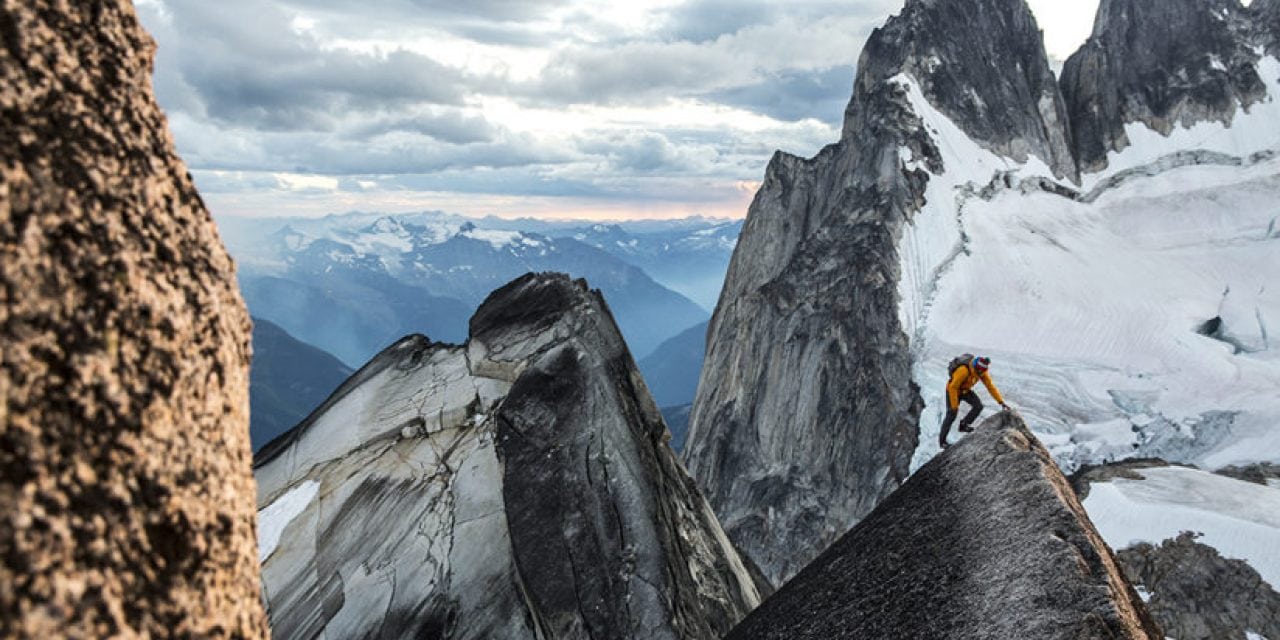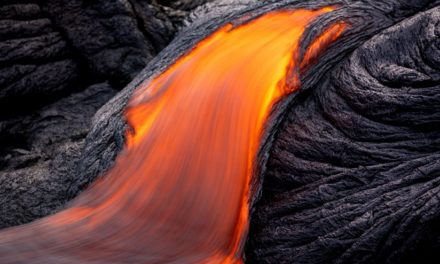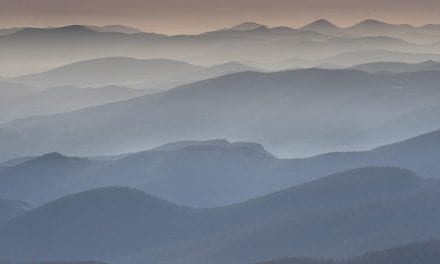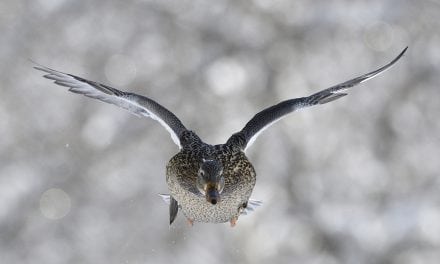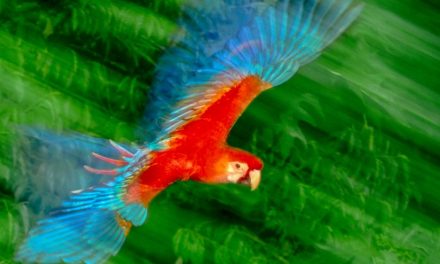
When someone talks about Jimmy Chin hanging around, it’s usually in reference to him on some dizzying cliff, camera in hand. And that’s exactly where the Jackson Hole, Wyoming-based photographer, filmmaker and mountain sports athlete wants to be.
At the dawn of the 21st century, his ability to capture extraordinary imagery while climbing and skiing in extremely high-risk environments came to the attention of both magazines and outdoor brands. In 2002, he secured a breakthrough assignment to be the cinematographer for a National Geographic-sponsored trek across Tibet’s Chang Tang Plateau. Four years later, Chin was part of the first American team to ski off the summit of Mt. Everest, as if climbing it wasn’t difficult enough. He continues to document experiences in places most of us fear to tread.
Outdoor Photographer: You’ve said in the past that trips to national parks with your parents shaped your life. How so?
Jimmy Chin: I grew up in Mankato, a very rural, very flat town in southcentral Minnesota. My parents worked as librarians at the university there and had the summers off, so we would pile into the car and drive to a national park. I remember distinctly, when I was around 8, we went to Glacier National Park. I remember looking at the mountains and thinking for the first time, “Wow, these are the kinds of mountains that mountain climbers climb.” They just looked amazing. I also remember thinking, “Why in the world would my parents choose to live where we lived when there are places like this out there in the world? Why aren’t we living here? When I get older, this is the place that I’m going to live.” I wanted to be in the mountains and see beautiful streams and be in the wilderness. Those surroundings still move me in a very deep way.

OP: What steps did you take to turn that childhood dream into a reality?
JC: My parents were stereotypical Chinese immigrants and parents. They were very focused on academics, getting their children into good schools, then a career as a lawyer, doctor, executive. That was the kind of path they wanted for me, which makes sense. I really fell in love with skiing pretty young, but I only got permission to do it if I did well in everything else. Then, while I was going to Carleton College, I found climbing.
OP: I remember the impact Seven Summits had on me at the beginning of my career. Since your parents were librarians, you must have been surrounded by books.
JC: Rick Ridgeway, who wrote the book [Seven Summits] with Dick Bass and Frank Wells, was my mentor. He basically coined the term. I’ve spent a lot of time with Rick; in fact, I’m meeting up with him in a week down in Chile. But at that time I didn’t read any mountaineering books, I was obsessed with rock climbing and skiing. The first summer after my freshman year, I drove straight back out to Glacier and worked at a convenience store in the park and then just started scrambling around on all the peaks up there and going on rock climbing excursions outside of the park. I did the same thing the summer after my sophomore year, this time waiting tables. When I got through school, I had a lot of pressure from my family to start a career, but I essentially moved into the back of a little Subaru car and went out to Yosemite and became a climbing bum, wandering around the West. As a climber, you follow the seasons. The usual circuit would be something like Rocky Mountain National Park, Yosemite National Park, Bears Ears National Monument, Joshua Tree National Park, the Kings Canyon/Sequoia area. In the north, I also like Smith Rock State Park in Oregon.
OP: Why did you end up living in the Tetons?
JC: I moved there for the skiing and have been there for the past 20 years. The entire landscape, the community, the summers, everything is inspiring about it. It’s one of the most beautiful places on the planet. In North America, the Tetons, the Bugaboos, Yosemite, Bears Ears and the Canyonlands are the places I’ve shot in the most.
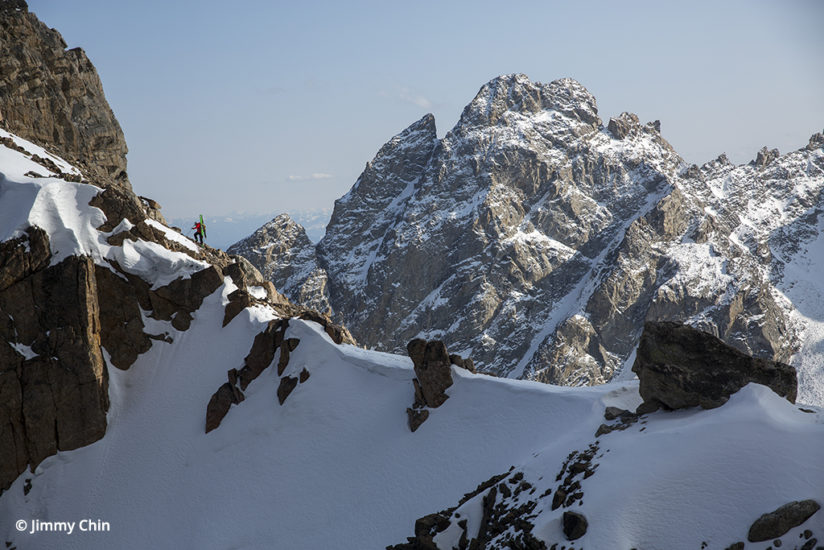
OP: What makes Yosemite the mecca for climbers?
JC: If you’re a pro surfer, you have to spend time on Oahu’s North Shore and surf the Pipeline. If you want to be a serious climber, you have to spend time in Yosemite. It has history, deep roots in the climbing culture. Unknowingly, you really don’t realize it at that age, you become part of that community, that tribe. Early on, I picked up a Nikon FM3 and started shooting. I started to take photographs of basically my friends, and my friends turned out to be the best climbers of their generation. Through the grapevine, I started getting asked if I could shoot them on some of their iconic climbs because I was a climber and I could keep up; I wasn’t a liability, I was part of the crew.
OP: What camera equipment are you climbing with now?
JC: I carry the Canon EOS 5D Mark IV with the 24-70mm and use tie climbing webbing to secure it.
OP: Do you carry lighting gear up with you as well?
JC: I only use natural light when I’m climbing, but the walls in many places are very reflective, and these days we have a lot of latitude in the shadows. If you’ve got a lot of good ambient light and some sort of fill coming off the wall, you have a lot to work with. There are very different styles of shooting. My favorite form of shooting is what I did in Antarctica, a very difficult climb, shooting on the fly, no posing, no assistants, no lighting. We are literally fighting for our lives up there. The weight of a mint is being weighed when we leave the ground. The camera itself is already an enormous compromise. It’s a day’s worth of food. That type of shooting is very different than what some people do in a place like Chamonix. You could take a cable car up to Aiguille-du-Midi and literally wrap off the railing and put somebody in a position and take shots of them all day long with lighting and make it look really extreme. There’s that type of shooting, and then there’s what I consider the very purest form, where you’re actually climbing. It’s not like you have a professional climber rig all the ropes for you and you ascend the ropes and shoot. You’re literally on a gigantic climb shooting and leading with a camera on.
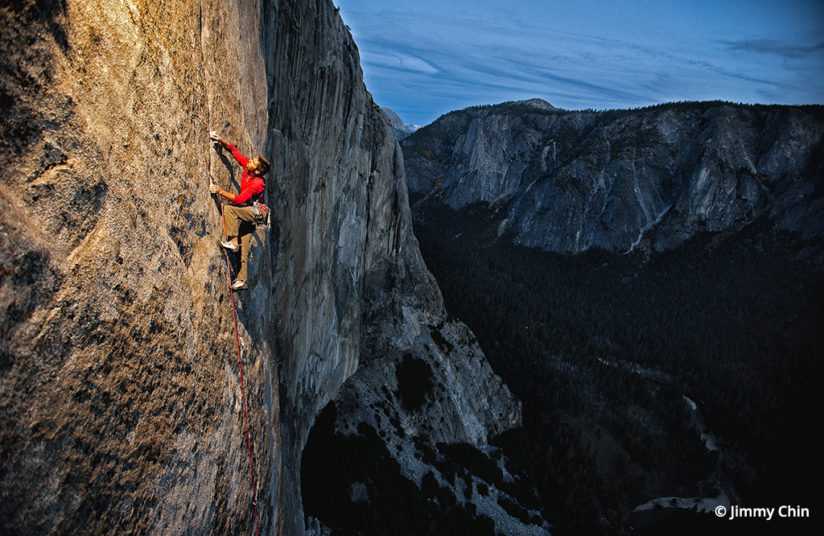
OP: Do you work with drones?
JC: I don’t. Most of the aerials you see for the moving stuff are done from helicopters. Drones are great, but you can’t work with a 1,000mm and do a giant reveal with a drone.
OP: Any non-photographic gear that helps you with your shooting?
JC: I’m on The North Face Athlete Team, and we’re working with the R&D team to develop the lightest and most durable clothing. If you are not comfortable or do not have the right equipment in the field, it has an immediate and direct impact on your ability to shoot. A big part of the planning for me comes down to my layering system and my equipment. You have to have all that stuff really dialed in. You might spend an entire day trying to get into one spot to get one image. And that window could be very short. If you don’t catch that window, you’ve missed the shot.
OP: To many people, it’s scary just looking at your images from an acrophobic point of view. Is there anything on this planet that scares you?
JC: Yeah. All the time. So why do I do what I do? It’s one of those things. If you don’t understand it, it’s hard to explain it. A lot of it has to do with being in the wilderness, having rich, meaningful experiences with people you care about. They are people like me who like to push themselves. There’s the physical and mental challenges of it. There’s the sense of accomplishment. There’s that deep satisfaction of doing and finishing something challenging.
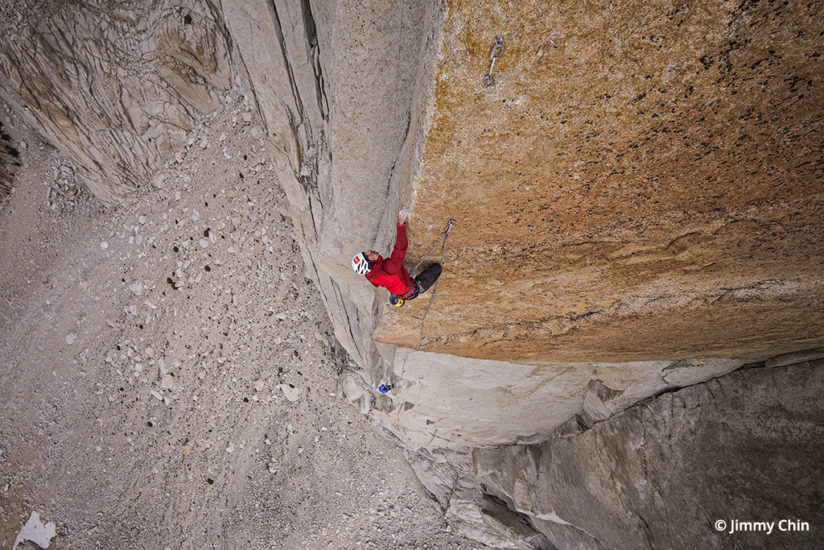
OP: As challenging as it is physically, the mental strength climbers must possess is incredible.
JC: Mental toughness for sure. I feel that a lot of people don’t understand it, but it’s actually very relatable to a lot of things everybody does in whatever field of work that they do—music, acting, law, medicine—where you really have to push yourself, whether that’s persevering through years of medical school or law school or persevering as a musician or actor being turned down for years then getting a lucky break. It’s about being passionate and committed to something you love, that is meaningful, that is an expression of who you are. People find things that give their lives purpose and meaning. They’re different for everybody. For us, fortunately or unfortunately, which is a common conversation, you don’t find your passion, your passion finds you. Climbing big high-altitude mountains in really remote areas happens to be the thing that found us.
OP: The experience seems very Zen. You have to be in the moment.
JC: It makes you very present. It’s incredible what it does to your senses. It really helps clear your mind. It’s a form of meditation. There’s nothing that will force you into the moment like climbing or skiing. Those are the things that do it for me. I think writers, basketball players, you can talk about any sort of craft or sport…
OP: How else could you make a 35-foot swoosh shot if you’re not in the moment?
JC: …with a 6’5” guy about to land on your head as you’re fading away from the basket.
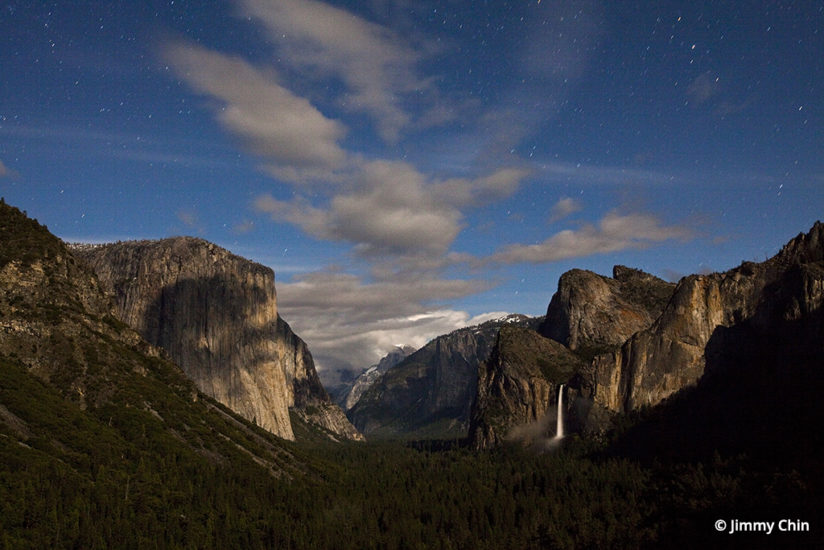
OP: What do you consider to be your toughest shoot in North America?
JC: The National Geographic assignment I shot about Yosemite was extremely challenging because of the pressure I put on myself. There’s no greater challenge in my mind than shooting for the Geographic. The bar is so high, your peer group is so incredibly talented. The tradition, the history of the magazine, it’s still the pinnacle to me. So there’s pressure to preform and create great imagery. You can talk with any Geographic photographer. It doesn’t matter how long they’ve been shooting for the magazine. “I need to create the best work of my life right now.” That’s a lot to put on yourself every day.
OP: What did you do to go about getting the desired results?
JC: I just settled in and started doing what I knew how to do. It was really about getting up every day and trying to make pictures. And planning. We tried to coordinate where the climbers were going to be at certain times of the day or climbing with them. It was also about showing the culture, the climbing community, hanging out and trying to get those moments.
OP: So trusting your experience and instincts and the relationships you’ve established.
JC: I’ve been shooting for 20 years, so I have some tricks up my sleeve such as closing down to ƒ/16 or ƒ/22 for a sunburst if I have to shoot into the sun, but so much of the focus in the shooting that I do is on the technical aspects of the actual activity or sport. Being able to climb and ski. Carrying my camera and ski equipment and climbing with crampons and ice axes up the mountain and being safe about it and trying to get ahead to shoot back down. The athleticism of the act of getting into the place. Some people joke, “You couldn’t take a bad picture from that spot.” I say, “Yeah, you’re right. Try getting to that spot!”
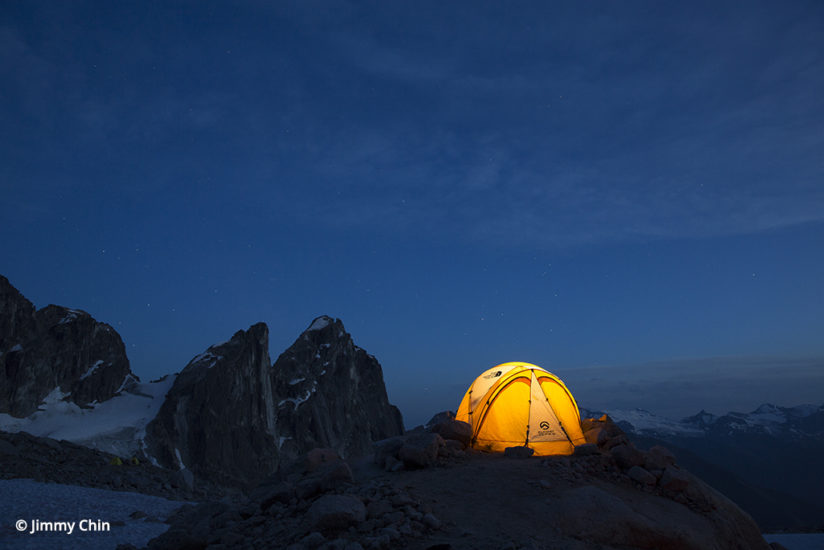
See more of Jimmy Chin’s work at jimmychin.com.
YOU MIGHT ALSO LIKE
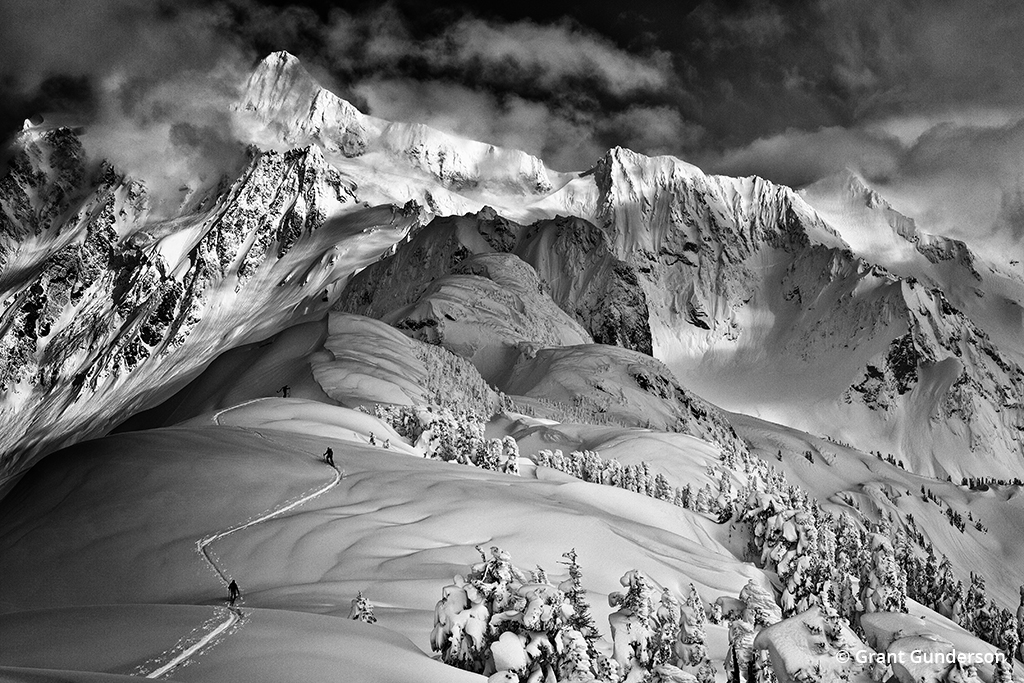
Big Air, Deep Powder
Grant Gunderson’s epic ski photography comes from a passion for the sport. Read now.
The post Life On The Edge With Jimmy Chin appeared first on Outdoor Photographer.

